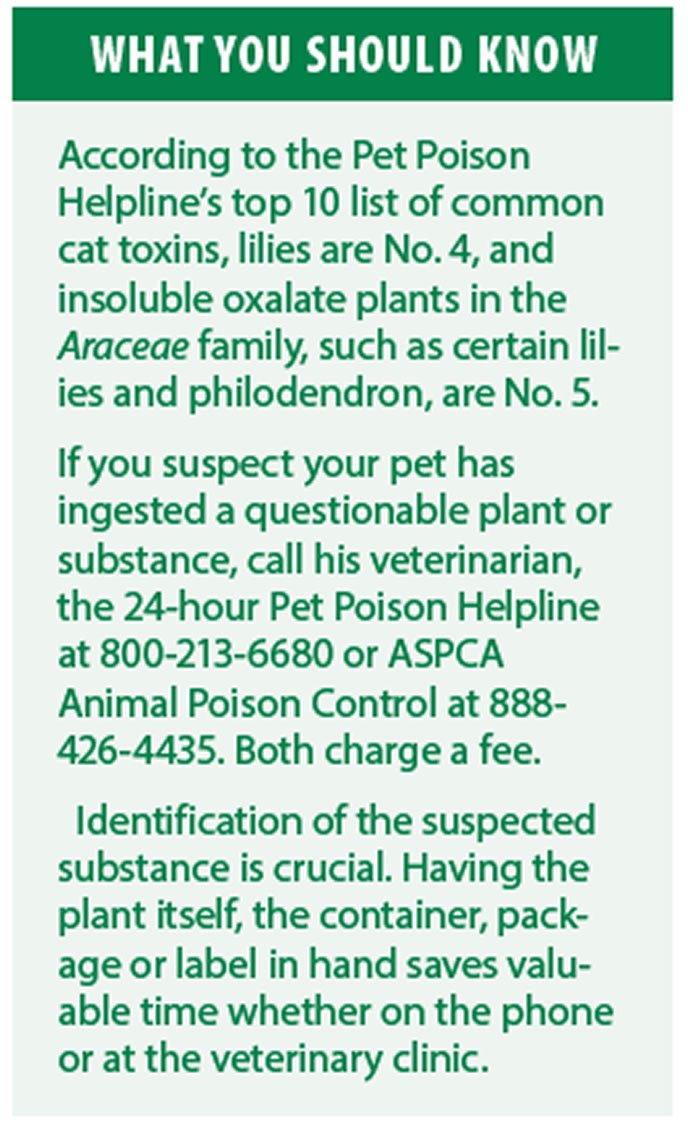A touch of green around the house during a long, cold winter provides a reminder of spring and creates a festive mood for the holidays. Although plants like lilies are lovely, the effects on a cat who ingests them are decidedly not. In the case of lilies of the Lilium species, cats can suffer potentially fatal kidney failure.
Lilies are tall perennials that grow from bulbs featuring large, prominent flowers with six petals. The flowers are often fragrant and come in a range of colors. Some, like tiger lilies, are orange with dark markings; others such as Easter lilies (Lilium longiflorum), with pure white, trumpet-shaped flowers, are traditional holiday favorites – but not among cat owners who know theyre poisonous.
Effects of Ingestion. Signs of ingestion in cats include vomiting, lack of appetite, lethargy and death if left untreated. Some of the cats we see have had symptoms for days, as their owners were unaware that lilies are toxic, says Elisa Mazzaferro, DVM, Ph.D., ACVECC, at Cornell University Veterinary Specialists in Stamford, Conn.

Bigstock
Unfortunately, by the time many of these cats come in, their kidney failure is irreversible. By contrast, when cats are caught early on, we can induce vomiting, then treat them in the hospital with IV fluids. Their prognosis is generally good, and they often go home to lead happy, healthy lives.
Other plants containing lily in their common name are actually unrelated to true lilies and are less toxic to cats. Some, such as Spathiphyllum, or peace lilies, are evergreens with a lily-like flower.
Like others in the Araceae family, including dieffenbachia and philodendron, these plants contain insoluble calcium oxalate crystals that cause irritation to the mouth, esophagus and stomach if ingested. Excessive salivation, vomiting and difficulty swallowing can also occur. Treatment consists of pain control, anti-nausea medication, other medications to coat the stomach and esophagus, and IV fluids if there is difficulty swallowing. Happily, the prognosis is good.
Aggressive Treatment. Lily of the valley, although not a true lily, is nevertheless poisonous and requires aggressive treatment. If ingested, severe signs can be seen, including vomiting, diarrhea, decreased heart rate, cardiac arrhythmias and seizures. (Certain lilies are also poisonous to dogs.)
Amaryllis plants such as Amaryllis belladonna – another flowering plant often confused with lilies – can cause lethargy, vomiting, diarrhea, excessive salivation, anorexia and tremors.
Despite their bright red leaves that seem to shout danger, poinsettias result in only mild vomiting and gastrointestinal discomfort, Dr. Mazzaferro says. Mistletoe, however, can cause vomiting and diarrhea, slow heart rate, low blood pressure and irritable, irregular behavior. Its a much more serious intoxication, she says.
Tree Oil Risks. While needles and oils from spruces, firs and pine trees can be irritants if ingested, they are not truly toxic. Common holiday plants often used in wreaths, including holly, English ivy and boxwood, pose greater risks. Their effects are generally similar. They can cause vomiting, excessive drooling, nausea and diarrhea, Dr. Mazzaferro says.

Treatment generally consists of anti-nausea medication and IV fluids if needed. One exception is the more toxic cyclamen, another popular flowering houseplant with upswept petals and patterned leaves – including Cyclamen coum that sports a Christmas tree pattern on its leaves. In addition to the previous symptoms, ingestion may also lead to abnormal heart rhythms, seizures and possible death. Treatment may include IV fluids, anti-nausea medication and other medications to counter abnormal heart rhythms, Dr. Mazzaferro says.
The best strategy to prevent holiday plant poisoning isnt keeping them out of reach. Curious, climbing cats can get to them. Dr. Mazzaferros recommendation: Before bringing a plant into household, check out the ASPCA Animal Poison Control [aspca.org] online list of poisonous plants, and dont bring these plants into the house.



